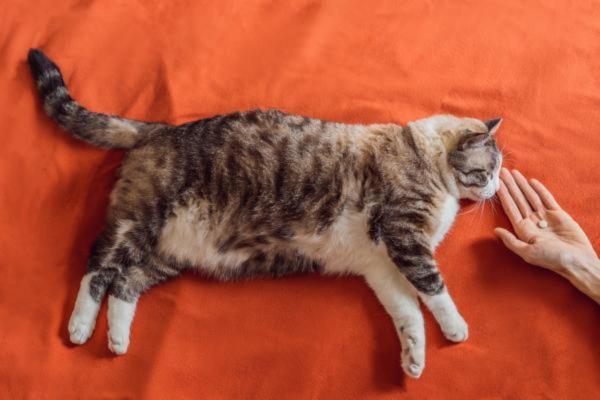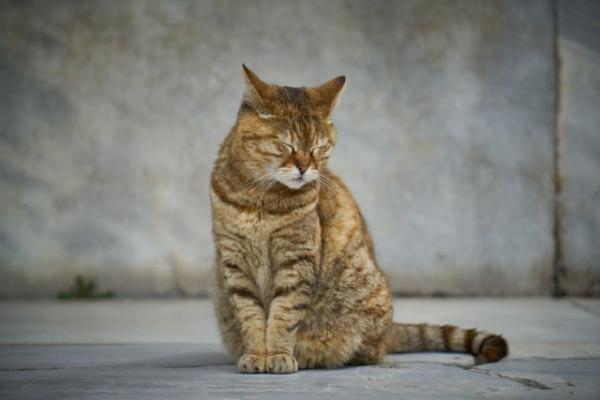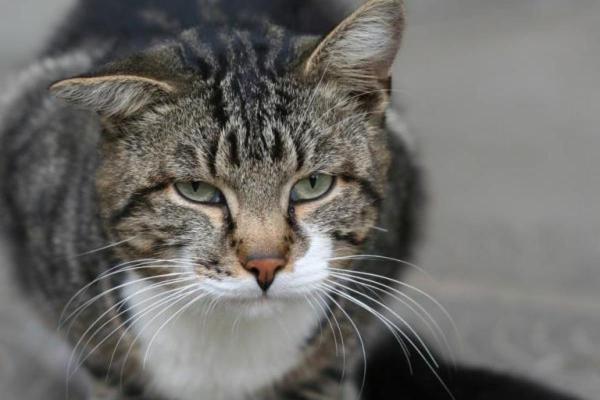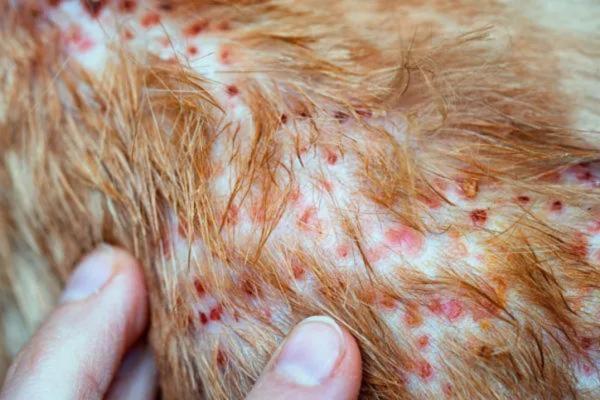
Older cats are more susceptible to various ailments due to the natural passage of time. While there are ways we can best ensure their health and well-being, no cat is immune to these changes once they reach a certain age. Deterioration of the musculoskeletal system is one of the most obvious signs of aging. The cat's gait, posture and even size can change as they enter their senior years. We may simply assume tremors to be one sign they are old. However, there are some diseases and conditions which have tremors as a symptom. These may need treatment, something especially important in older cats as they often have a relatively weak immune system.
At AnimalWised, we explain why your old cat has tremors. We explain the reasons behind these tremors and spasms, as well as what you can do to treat them.
Feline hyperesthesia syndrome
Hyperesthesia is a condition that manifests in hypersensitivity of the skin. For humans and many other animals, it is usually a symptom of an underlying disease or health condition. For cats, feline hyperesthesia syndrome is a specific health condition which can affect cats of any age, usually as long as they have reached maturity.
While muscle tremors are a common symptom, the spasms often lead the cat to groom the lumbar area where the tremors are most prevalent. These tremors appear in episodes which eventually cease, but can reoccur. In some cases, the cat can even start biting and scratching the area which can lead to self-mutilation. Emotional stress from the frustration and anxiety can also lead to aggressiveness.
Feline hyperesthesia is not a degenerative disease, nor is it considered fatal. However, cats can develop severe behavioral disorders or even secondary infections due to mutilation of their skin. Fortunately, these are in the minority of cases.
This condition affects various systems in the body. Not just the musculoskeletal system, but the nervous system, endocrine system and others. There is no known cause, with many proposals suggesting it may be neurological, genetic or behavioral in origin, but there is insufficient evidence to confirm any theory. Although there is not consensus on the cause of feline hyperesthesia syndrome, it is believed the following are significant factors:
- Stress
- Obsessive compulsive disorder
- Feline epilepsy
We may notice our older cat has hyperesthesia when we stroke them on the sides and lumbar area. Their muscles may twitch and tremor very easily with only the lightest touching. The cat will enter episodes similar to when they have a seizure of some kind. Their pupils will dilate, they will become agitated, try to scratch the area and may even suffer from hallucinations.
Treatment of feline hyperesthesia
The treatment of hyperesthesia in older cats should focus on reducing the stressful stimuli that prevent the cat from calming down. Practically, we can adapt their environment to reduce anxiety by:
- Using synthetic pheromones
- Playing with and stimulating our cat when possible
- Using scratching posts, cat trees and other forms of environmental enrichment
In the most acute cases, medical therapy should be added to reduce their state of anxiety through corticosteroids. If you want to know more about feline hyperesthesia, symptoms and treatment , do not hesitate to consult the following AnimalWised article.
Seizures
When your cat has seizures, it means they have epilepsy. The two terms are often used interchangeably and they refer to a common neurological problem which has physical manifestations. Seizures are convulsive attacks which cause the animal to have varying symptoms. Muscle tremors and spasms can be slight or so severe they threaten the cat's life. They may also have hypersalivation, loss of conscious, lip smacking and other symptoms.
These attacks occur when a neuronal group is suddenly activated, causing agitation and overexcitation of their muscles. This can affect a specific muscle or muscle group of the cat (focal epilepsies) or of all their musculature (generalized epilepsies).
The causes range from:
- An indeterminate origin
- Diseases that damage the brain
- Intoxication
- Liver or kidney diseases
- Thiamine deficiency
- Vascular causes
When a cat is convulsing, they can range from simple spasms of short duration to intense tremors of their entire body for several minutes. The latter can cause an increase in body temperature or hyperthermia that is very dangerous for your cat, especially if it lasts longer than 10 minutes.
Treatment of seizures in cats
The treatment of feline epilepsy in older cats is based on the use of drugs to reduce the intensity and frequency of epileptic seizures. Phenobarbital for cats is commonly administered. This drug can also help prevent severe seizures lasting more than ten minutes, but if they occur they are a matter of urgency, they require the use of intravenous anticonvulsants or rectal diazepam.

Hypoglycemia
Your older cat may also have spasms as a result of low blood sugar (blood glucose levels), a condition known as hypoglycemia. Glucose is the main energy substrate of the body and provides fuel for the brain. When the amount of sugar is reduced, cats begin to have problems such losing consciousness, dizziness and trembling.
The causes range from:
- Inadequate control of diabetes in affected cats
- Pancreatic tumor
- Liver disease
- Systemic infection
- Intestinal malabsorption
- Fasting
- Prolonged seizures
- Excess carbohydrates in the diet
In addition to tremors and twitching, cats with hypoglycemia may exhibit rapid heart rate, confusion, altered appetite, depression, blurred vision, heart palpitations, ataxia, weakness and lethargy.
Treatment of feline hypoglycemia
Hypoglycemia is treated by the use of intravenous dextrose. You can also try applying honey to the edge of their mouth so that the sugar is absorbed quickly. This is a temporary solution and not a replacement for medical treatment. When hypoglycemia is a consequence of high doses of insulin in older diabetic cats, corticosteroids can be used to antagonize the action of insulin. In the event that it is caused by an organic disease, it must be treated.
Learn more about this condition with our article on hypoglycemia in cats.

Pain
Older cats can also have spasms secondary to painful processes such as arthritis, osteoarthritis or trauma that will make your cat more reluctant to move. They may have tremors, as well as changes in mood. The pain can also be secondary to an organic disease that is common in older cats, such as pancreatitis or digestive diseases. Your cat may be suffering pain if they:
- Hide more often
- Behavior has changed
- Have less vitality
- Request play less often
- Stop jumping to heights
Learn more with our article on signs your cat is in pain.
feline pain treatment
Pain in cats is treated pharmacologically through the use of analgesic and/or anti-inflammatory drugs. These include nonsteroidal anti-inflammatory drugs (NSAIDs). In the most severe cases, opioids such as buprenorphine or methadone may be used. Whenever the cause has a solution, the cat should be treated as chronic pain can serious lower their quality of life.

Poisoning
If your older cat has been exposed to a toxic substance or has ingested something poisonous such as a toxic plant, drug or chemical product, they may have spasms as a result. Poisoning in cats can give rise to very different signs depending on the nature of the poison, but they usually produce:
- Digestive signs such as vomiting and diarrhea
- Cardiorespiratory-nervous signs such as tremors
When the tissues collapse due to an insufficient blood supply, the cat will go into toxic shock. We can see this is the cat has pale mucus membranes, cold extremities and an altered heart rate. This is especially worrying in older cats as their organism is less likely to cope than a younger cat with higher immunity.
Treatment of poisoning in cats
Depending on the poisoning in question, a specific antidote may be applied in some cases. In most cases of intoxication of older cats it is not possible. Depending on the time that has passed since the ingestion of the poison, treatment could involve:
- Inducing vomiting
- Using adsorbent substances (e.g. charcoal)
- Gastric lavage (stomach pump)
Supportive treatment such as fluid therapy will likely be required as the cat recovers. Do not try to induce vomiting at home without guidance. If you do not have time to go to a veterinary surgery, call emergency veterinary services and follow their guidelines.
Dermatitis
Sometimes our older cats may have skin problems caused by external parasites. Fleas, lice, mites, ticks and others cause cats to tremble or contract their muscles to counteract this action. Older cats may also suffer from skin diseases or infections that cause dermatitis. These can result in skin lesions that cause discomfort, overgrooming, restlessness and twitching.
Treatment of feline dermatitis
The treatment of skin inflammation in cats will depend on the underlying cause:
- External parasitosis: effective deworming treatment should be used to kill these annoying organisms, as well as adopt preventive antiparasitic measures to avoid future parasitization.
- Dermatological condition or disease: this must be diagnosed and treated specifically by your veterinarian to prevent your older cat from continuing to spasm.
Do not hesitate to take a look at the following article to read more about atopic symptoms and treatment of miliary dermatitis in cats.

hyperthermia
Our cats are comfortable in ambient temperatures between 17 and 30 ºC/62.6 and 86 ºF. This helps maintain a stable body temperature. Cats with little-to-no hair may need warmer temperatures and cats with long hair may fare better in lower temperatures. Any cat with a very body temperature above 39.2 ºC/102.5 ºF has hyperthermia, often referred to as heat stroke in cats. Symptoms of feline heat stroke include:
- Spasms or tremors
- Vomiting
- Excessive panting
- Altered cardiac rhythm
- Lack of oxygen
- Difficulty maintaining body posture
Treatment of hyperthermia in older cats
When an older cat has hyperthermia, they must be treated effectively by cooling down the body. We can do this by moistening cloths and applying cold compresses, as well as using fluids to hydrate and cool their body internally. In some cases, additional drugs such as antiemetics, gastric protectors or others will be necessary. In the worst cases of shock, your cat will need to be hospitalized.

Hypothermia
Conversely, our cats can also suffer spasms as a result of low external temperatures that reduce their body temperature below 35ºC/95 ºF, causing serious damage to their body. In addition to spasms, cats with hypothermia exhibit:
- Dry Skin
- Lethargy
- Slow breathing and heart rate
- Clumsy movement
- Hypotension
- Hypoglycemia
- Lost look
- Collapse
- Multi-organ dysfunction
- Fainting
Treatment of feline hypothermia
Feline hypothermia should be treated as soon as possible. In addition to preventing tremors and other symptoms, we need to avoid multiple organ failure caused by low body temperature. Treatment consists of increasing the cat's body temperature using heaters, wrapping them in blankets, applying enemas or warm fluids, and increasing glucose with medication if they are hypoglycemic.
We should never increase or decrease the cat's body temperature too suddenly. For example, we cannot place a hypothermic cat in a hot bath. The shock from going from one temperature extreme to another can be fatal, especially in senior cats.
This article is purely informative. AnimalWised does not have the authority to prescribe any veterinary treatment or create a diagnosis. We invite you to take your pet to the veterinarian if they are suffering from any condition or pain.
If you want to read similar articles to My Old Cat Has Tremors - Causes and Treatment, we recommend you visit our Other health problems category.
- Perez, G. (2018). First aid for cats. Arcopress, S. L.
- Nelson, R. W. (2020). Small animal internal medicine, 6th edition. Assisi Group Biomedia, S. L.